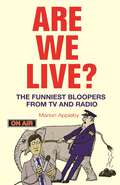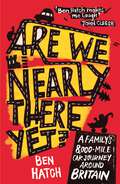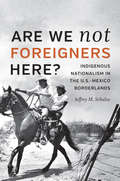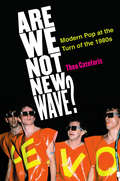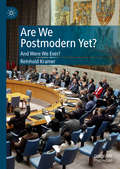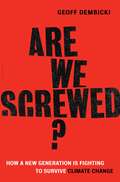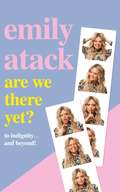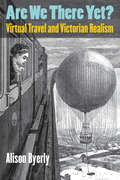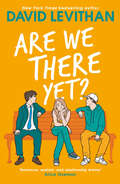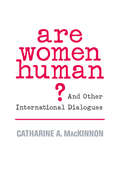- Table View
- List View
Are We Live?: The Funniest Bloopers from TV and Radio
by Marion ApplebyAre We Live? is a book about all the things that can and have gone wrong in a broadcasting studio. And, boy, has a lot of stuff gone wrong!Whether it's BBC Radio 4's appropriately-named James Naughtie dropping the c-bomb on the usually prudent Today programme, or an Antiques Roadshow ceramic expert mistakenly describing a piece of Victoria Regina porcelain as 'Rictoria Vagina', Are We Live? takes in the full spectrum of comedy gold captured on film - whether intentional or not!
Are We Lost? Red B Level 2B: Comet Street Kids (PDF)
by Adam GuillainThe Comet Street Kids are exploring the Planet Zoom theme park, which is great fun until they get lost! They have a map, but it's no help. Can they work out how to find out where they are? Are we Lost? is part of the Comet Street Kids range of books from Rising Stars Reading Planet. Comet Street Kids is an action-packed character series with highly decodable books for Pink A to White band. Children will love experiencing the amazing adventures of Rav, Asha, Tess, Finn and Stefan! Reading Planet books have been carefully levelled to support children in becoming fluent and confident readers. Each book features useful notes and activities to support reading at home as well as comprehension questions to check understanding. Reading age: 4-5 years.
Are We Nearly There Yet?: A Family's 8,000-Mile Car Journey Around Britain
by Ben HatchWhen Ben and Dinah saw the advert looking for a husband and wife team with young kids to write a guidebook about family travel around Britain, they jumped at the chance. They embark on a mad-cap five-month trip, embracing the freedom of the open road with a spirit of discovery and an industrial supply of baby wipes.
Are We Nearly There Yet?: The ultimate laugh-out-loud holiday read to pack in your beach bag this summer
by Lucy Vine'Utterly addictive and utterly charming...her best yet' Daisy Buchanan'Have you ever messed up so badly you had to leave the country? This feelgood journey contains one of the best vagina jokes ever. We didn't want it to end' Heat MagazineAlice is turning thirty and is stuck in a rut. Her friends are all coupling up and settling down, while she's still working as a temp, trying (and failing) not to shag her terrible ex, getting thrown out of clubs, and accidentally sexting her boss...She decides to throw caution to the wind and jets off on a round-the-world adventure to #FindTheFun and find herself. Of course, she's no more likely to find the answer to true happiness on the beach in Thailand than she is at the electric beach in Tooting, but at least in Thailand there's paddleboard yoga.Can Alice find happiness on her travels? Or is she more likely to lose herself all over again...?'Really, really funny, but also kind of heart wrenching' Sophie Kinsella'Hilarious and touching' Louise O'Neill 'Warning: read this book and you will doubtless snort with laughter in inappropriate public places. Quite simply, #brilliant' Ella Dove'Her best work yet: it's funner, it's more tender . . . You need to have this in your beach bag' Laura Jane Williams'I tore through this quicker than a duty-free Toblerone . . . Wickedly funny and painfully perceptive' Lauren Bravo
Are We Not Foreigners Here?: Indigenous Nationalism in the U.S.-Mexico Borderlands
by Jeffrey M. SchulzeSince its inception, the U.S.-Mexico border has invited the creation of cultural, economic, and political networks that often function in defiance of surrounding nation-states. It has also produced individual and group identities that are as subversive as they are dynamic. In Are We Not Foreigners Here?, Jeffrey M. Schulze explores how the U.S.-Mexico border shaped the concepts of nationhood and survival strategies of three Indigenous tribes who live in this borderland: the Yaqui, Kickapoo, and Tohono O'odham. These tribes have historically fought against nation-state interference, employing strategies that draw on their transnational orientation to survive and thrive. Schulze details the complexities of the tribes' claims to nationhood in the context of the border from the nineteenth century to the present. He shows that in spreading themselves across two powerful, omnipresent nation-states, these tribes managed to maintain separation from currents of federal Indian policy in both countries; at the same time, it could also leave them culturally and politically vulnerable, especially as surrounding powers stepped up their efforts to control transborder traffic. Schulze underlines these tribes' efforts to reconcile their commitment to preserving their identities, asserting their nationhood, and creating transnational links of resistance with an increasingly formidable international boundary.
Are We Not Foreigners Here?: Indigenous Nationalism in the U.S.-Mexico Borderlands
by Jeffrey M. SchulzeSince its inception, the U.S.-Mexico border has invited the creation of cultural, economic, and political networks that often function in defiance of surrounding nation-states. It has also produced individual and group identities that are as subversive as they are dynamic. In Are We Not Foreigners Here?, Jeffrey M. Schulze explores how the U.S.-Mexico border shaped the concepts of nationhood and survival strategies of three Indigenous tribes who live in this borderland: the Yaqui, Kickapoo, and Tohono O'odham. These tribes have historically fought against nation-state interference, employing strategies that draw on their transnational orientation to survive and thrive. Schulze details the complexities of the tribes' claims to nationhood in the context of the border from the nineteenth century to the present. He shows that in spreading themselves across two powerful, omnipresent nation-states, these tribes managed to maintain separation from currents of federal Indian policy in both countries; at the same time, it could also leave them culturally and politically vulnerable, especially as surrounding powers stepped up their efforts to control transborder traffic. Schulze underlines these tribes' efforts to reconcile their commitment to preserving their identities, asserting their nationhood, and creating transnational links of resistance with an increasingly formidable international boundary.
Are We Not Men?: Unstable Masculinity in the Hebrew Prophets
by Rhiannon GraybillAre We Not Men? offers an innovative approach to gender and embodiment in the Hebrew Bible, revealing the male body as a source of persistent difficulty for the Hebrew prophets. Drawing together key moments in prophetic embodiment, Graybill demonstrates that the prophetic body is a queer body, and its very instability makes possible new understandings of biblical masculinity. Prophecy disrupts the performance of masculinity and demands new ways of inhabiting the body and negotiating gender. Graybill explores prophetic masculinity through critical readings of a number of prophetic bodies, including Isaiah, Moses, Hosea, Jeremiah, and Ezekiel. In addition to close readings of the biblical texts, this account engages with modern intertexts drawn from philosophy, psychoanalysis, and horror films: Isaiah meets the poetry of Anne Carson; Hosea is seen through the lens of possession films and feminist film theory; Jeremiah intersects with psychoanalytic discourses of hysteria; and Ezekiel encounters Daniel Paul Schreber's Memoirs of My Nervous Illness. Graybill also offers a careful analysis of the body of Moses. Her methods highlight unexpected features of the biblical texts, and illuminate the peculiar intersections of masculinity, prophecy, and the body in and beyond the Hebrew Bible. This assembly of prophets, bodies, and readings makes clear that attending to prophecy and to prophetic masculinity is an important task for queer reading. Biblical prophecy engenders new forms of masculinity and embodiment; Are We Not Men?offers a valuable map of this still-uncharted terrain.
ARE WE NOT MEN C: Unstable Masculinity in the Hebrew Prophets
by Rhiannon GraybillAre We Not Men? offers an innovative approach to gender and embodiment in the Hebrew Bible, revealing the male body as a source of persistent difficulty for the Hebrew prophets. Drawing together key moments in prophetic embodiment, Graybill demonstrates that the prophetic body is a queer body, and its very instability makes possible new understandings of biblical masculinity. Prophecy disrupts the performance of masculinity and demands new ways of inhabiting the body and negotiating gender. Graybill explores prophetic masculinity through critical readings of a number of prophetic bodies, including Isaiah, Moses, Hosea, Jeremiah, and Ezekiel. In addition to close readings of the biblical texts, this account engages with modern intertexts drawn from philosophy, psychoanalysis, and horror films: Isaiah meets the poetry of Anne Carson; Hosea is seen through the lens of possession films and feminist film theory; Jeremiah intersects with psychoanalytic discourses of hysteria; and Ezekiel encounters Daniel Paul Schreber's Memoirs of My Nervous Illness. Graybill also offers a careful analysis of the body of Moses. Her methods highlight unexpected features of the biblical texts, and illuminate the peculiar intersections of masculinity, prophecy, and the body in and beyond the Hebrew Bible. This assembly of prophets, bodies, and readings makes clear that attending to prophecy and to prophetic masculinity is an important task for queer reading. Biblical prophecy engenders new forms of masculinity and embodiment; Are We Not Men?offers a valuable map of this still-uncharted terrain.
Are We Not New Wave?: Modern Pop at the Turn of the 1980s (Tracking Pop)
by Theo Cateforis“Are We Not New Wave? is destined to become the definitive study of new wave music.” —Mark Spicer, coeditor of Sounding Out Pop New wave emerged at the turn of the 1980s as a pop music movement cast in the image of punk rock’s sneering demeanor, yet rendered more accessible and sophisticated. Artists such as the Cars, Devo, the Talking Heads, and the Human League leapt into the Top 40 with a novel sound that broke with the staid rock clichés of the 1970s and pointed the way to a more modern pop style. In Are We Not New Wave? Theo Cateforis provides the first musical and cultural history of the new wave movement, charting its rise out of mid-1970s punk to its ubiquitous early 1980s MTV presence and downfall in the mid-1980s. The book also explores the meanings behind the music’s distinctive traits—its characteristic whiteness and nervousness; its playful irony, electronic melodies, and crossover experimentations. Cateforis traces new wave’s modern sensibilities back to the space-age consumer culture of the late 1950s/early 1960s. Three decades after its rise and fall, new wave’s influence looms large over the contemporary pop scene, recycled and celebrated not only in reunion tours, VH1 nostalgia specials, and “80s night” dance clubs but in the music of artists as diverse as Rihanna, Lady Gaga, Miley Cyrus, and the Killers.
Are We Postmodern Yet?: And Were We Ever?
by Reinhold KramerIn this book, Reinhold Kramer explores a variety of important social changes, including the resistance to objective measures of truth, the rise of “How-I-Feel” ethics, the ascendancy of individualism, the immersion in cyber-simulations, the push toward globalization and multilateralism, and the decline of political and religious faiths. He argues that the displacement, since the 1990s, of grand narratives by ego-based narratives and small narratives has proven inadequate, and that selective adherence, pluralist adaptation, and humanism are more worthy replacements. Relying on evolutionary psychology as much as on Charles Taylor, Kramer argues that no single answer is possible to the book title’s question, but that the term “postmodernity” – referring to the era, not to postmodernism – still usefully describes major currents within the contemporary world.
Are We Pushing Animals to Their Biological Limits?: Welfare and Ethical Implications
by Temple Grandin Martin WhitingStimulating and thought-provoking, this important new text looks at the welfare problems and philosophical and ethical issues that are caused by changes made to an animal's telos, behaviour and physiology, both positive and negative, to make them more productive or adapted for human uses. These changes may involve selective breeding for production, appearance traits, or competitive advantage in sport, transgenic animals or the use of pharmaceuticals or hormones to enhance production or performance. Changes may impose duties to care for these animals further and more intensely, or they may make the animal more robust. The book considers a wide range of animals, including farm animals, companion animals and laboratory animals. It reviews the ethics and welfare issues of animals that have been adapted for sport, as companions, in work, as ornaments, food sources, guarding and a whole host of other human functions. This important new book sparks debate and is essential reading for all those involved in animal welfare and ethics, including veterinarians, animal scientists, animal welfare scientists and ethologists.
Are We Safe Enough?: Measuring and Assessing Aviation Security
by John Mueller Mark G. StewartAre We Safe Enough? Measuring and Assessing Aviation Security explains how standard risk analytic and cost-benefit analysis can be applied to aviation security in systematic and easy-to-understand steps. The book evaluates and puts into sensible context the risks associated with air travel, the risk appetite of airlines and regulators and the notion of acceptable risk. It does so by describing the effectiveness, risk reduction and cost of each layer of aviation security, from policing and intelligence to checkpoint passenger screening to arming pilots on the flight deck. Quantifies the risks, costs and benefits of various aviation security methods, including policing, intelligence, PreCheck, checkpoint passenger screening, behavioral detection, air marshals and armed pilotsFocuses on security measures that reduce costs without reducing security, including PreCheck, Federal Flight Deck Officer program and Installed Physical Secondary BarriersFeatures risk-reduction insights with global applications that are fully transparent, and fully explored through sensitivity analysis
Are We Screwed?: How a New Generation is Fighting to Survive Climate Change
by Geoff DembickiA declaration of resistance, and a roadmap for radical change, from the generation that will be most screwed by climate change. The Millennial generation could be first to experience the doomsday impacts of climate change. It's also the last generation able to do something about them. With time ticking down, 31-year-old journalist Geoff Dembicki journeyed to Silicon Valley, Canada's tar sands, Washington, DC, Wall Street and the Paris climate talks to find out if he should hope or despair. What he learned surprised him. Millions of people his age want to radically change our world, and they are at the forefront of resistance to the politicians and CEOs steering our planet towards disaster. In Are We Screwed?, Dembicki gives a firsthand account of this movement, and the shift in generational values behind it, through the stories of young people fighting for their survival. It begins with a student who abandons society to live in the rainforest and ends with a Muslim feminist fomenting a political revolution. We meet a Brooklyn artist terrifying the oil industry, a Norwegian scientist running across the melting Arctic and an indigenous filmmaker challenging the worldview of Mark Zuckerberg. Are We Screwed? makes a bold argument in these troubled times: A safer and more equitable future is more achievable than we've been led to believe. This book will forever change how you view the biggest existential challenge of our era and redefine the generation now battling against the odds to solve it.
Are We There Yet?: To indignity . . . and beyond!
by Emily AtackWarm, charming and remarkably honest - GraziaThe highs, the lows, the hangovers, the relationships, the lucky breaks (and the breaks I worked my arse off for) that have got me to the here and now. Emily Atack was flung to fame at just 17, as Charlotte 'Big Jugs' Hinchcliffe in The Inbetweeners. Nearly ten years later, she won over the nation on I'm a Celebrity . . . Get Me out of Here! thanks to her hilarious impersonations and epic bravery during trials. While she was in the jungle, the country watched her go on a journey of self-acceptance and come out on top. Now Emily reveals the hilarious highs and the heartbreakinglows that rocked the years between. With astonishing courage and her trademark humour, she shares stories about her family, relationships, work life and love.Are We There Yet? is a warm, honest and funny book for anyone who has ever felt the need to break the mould to find out who they really are.
Are We There Yet?
by Enid BlytonMike, Belinda and Ann love the summer holidays. Every year there's a different adventure in store. Whether they're exploring idyllic Seagull Cove, cosying up in the family caravan, gliding down a narrow canal in a houseboat or sailing the high seas on a glamorous ocean liner, they know they'll always have fun. And there's bound to be something delicious for tea!This is a bumper bind-up collection of all 6 books from the Family series:The Caravan FamilyThe Buttercup Farm FamilyThe Seaside FamilyThe Pole Star FamilyThe Saucy Jane FamilyThe Queen Elizabeth Family
Are We There Yet?: Virtual Travel and Victorian Realism
by Alison ByerlyAre We There Yet? Virtual Travel and Victorian Realism connects the Victorian fascination with "virtual travel" with the rise of realism in nineteenth-century fiction and twenty-first-century experiments in virtual reality. Even as the expansion of river and railway networks in the nineteenth century made travel easier than ever before, staying at home and fantasizing about travel turned into a favorite pastime. New ways of representing place—360-degree panoramas, foldout river maps, exhaustive railway guides—offered themselves as substitutes for actual travel. Thinking of these representations as a form of "virtual travel" reveals a surprising continuity between the Victorian fascination with imaginative dislocation and twenty-first -century efforts to use digital technology to expand the physical boundaries of the self.
Are We There Yet?
by David LevithanSometimes your destination is not where you arrive… A gorgeously thoughtful novel by the co-author with John Green of ‘Will Grayson, Will Grayson’
Are We There Yet?: Rosie's Rides: Are We There Yet? (Start Reading: Rosie's Rides)
by Jillian PowellStart Reading is a new series of highly enjoyable books for beginning readers at KS1. They have been carefully graded to correspond to the Book Bands now widely used in schools. This enables readers to be sure that they choose books that match their own ability. There is very careful and gentle graduation from Band to Band. The books can be shared with an adult or read independently. They promote the enjoyment of reading through reading real, satisfying stories with a beginning, a middle and an end. Rosie's Rides is at Book Band 3 in the Start Reading series. Rosie is going on all sorts of Rides, rollercoaster rides, pony rides, jeep rides and train rides. All have their adventures.
Are Women Human?: And Other International Dialogues
by Catharine A. MacKinnonMore than half a century after the Universal Declaration of Human Rights defined what a human being is and is entitled to, Catharine MacKinnon asks: Are women human yet? She exposes the consequences and significance of the systematic maltreatment of women and its systemic condonation as she points toward fresh ways of targeting its toxic orthodoxies. A critique of the transnational status quo that also envisions the transforming possibilities of human rights, this bracing book makes us look as never before at an ongoing war too long undeclared.
Are Women Human?: And Other International Dialogues
by Catharine A. MacKinnonMore than half a century after the Universal Declaration of Human Rights defined what a human being is and is entitled to, Catharine MacKinnon asks: Are women human yet? She exposes the consequences and significance of the systematic maltreatment of women and its systemic condonation as she points toward fresh ways of targeting its toxic orthodoxies. A critique of the transnational status quo that also envisions the transforming possibilities of human rights, this bracing book makes us look as never before at an ongoing war too long undeclared.
Are Workarounds Ethical?: Managing Moral Problems in Health Care Systems
by Nancy BerlingerHow work gets done in complex health care systems is ethically important. When health care professionals and other staff are pressured to improvise, fix structural problems, or comply with competing policies, the uncertainty and distress they experience have potential consequences for patients, families, colleagues, and the system itself. This book presents a new theory of health care ethics that is grounded in the nature of health care work and how it is shaped by the ever-changing conditions of complex systems, in particular, problems of safety and harm. By exploring workarounds and other improvised practices in complex health care systems that are difficult for professionals to talk about openly, yet have unclear effects, including their value or risk to patients, this book offers a realistic look at our changing health care system and how we can improve the way we manage moral problems arising in the care of the sick. Berlinger argues that health care ethics in complex and changing health care systems should reflect the moral complexity of health care work, analyze common ethical challenges with reference to behaviors and pressures driven by the system itself, and support opportunities for health care professionals and staff at all levels to reflect on the problems they face and to take part in social change. The book's chapters include frameworks for looking at ethical challenges in health care as problems of safety and harm with consequences for patients. Are Workarounds Ethical? is designed to support clinician education in medicine, nursing, and interdisciplinary contexts and recommend methods for integrating ethics, safety, and justice in practice.
Are Workarounds Ethical?: Managing Moral Problems in Health Care Systems
by Nancy BerlingerHow work gets done in complex health care systems is ethically important. When health care professionals and other staff are pressured to improvise, fix structural problems, or comply with competing policies, the uncertainty and distress they experience have potential consequences for patients, families, colleagues, and the system itself. This book presents a new theory of health care ethics that is grounded in the nature of health care work and how it is shaped by the ever-changing conditions of complex systems, in particular, problems of safety and harm. By exploring workarounds and other improvised practices in complex health care systems that are difficult for professionals to talk about openly, yet have unclear effects, including their value or risk to patients, this book offers a realistic look at our changing health care system and how we can improve the way we manage moral problems arising in the care of the sick. Berlinger argues that health care ethics in complex and changing health care systems should reflect the moral complexity of health care work, analyze common ethical challenges with reference to behaviors and pressures driven by the system itself, and support opportunities for health care professionals and staff at all levels to reflect on the problems they face and to take part in social change. The book's chapters include frameworks for looking at ethical challenges in health care as problems of safety and harm with consequences for patients. Are Workarounds Ethical? is designed to support clinician education in medicine, nursing, and interdisciplinary contexts and recommend methods for integrating ethics, safety, and justice in practice.
Are you a badger or a doormat?: How To Be A Leader Who Gets Results (Financial Times Series)
by Rosie MillerUsing memorable caricatures to highlight the effects of your behaviour as a leader, this book offers a powerful model for effective leadership Are you a Badger or a Doormat? provides you with clear instructions and simple self-coaching processes which will propel you along the path to leadership success. It uses memorable caricatures to show extreme leadership styles, teaching you what behaviour to avoid and what to do more of, in an accessible and amusing way. Throughout the book Rosie Miller, a top international executive coach, and 20 highly experienced leaders offer advice on the mindsets, habits and working practices that will make you a successful leader. This book gives you the practical and direct guidance you need to upgrade your thinking and your behaviour to become an energetic, focused and visionary leader. The focus is on the five skills common to all the most effective leaders: making the best use of your time communicating effectively delegating and people development motivating a diverse workforce creating change Each chapter is broken down into the following clearly sign-posted sections: Highlightscontaining the key ideas in brief to enable you to scan quickly the content a description of a common leadership Dilemma using cartoon caricatures to illustrate two extreme types of leadership behaviour and illustrate the unintended consequences of these extremes in practice a Diagnostic for those who want to assess where they tend to fit between the two ends of the continuum Balancing Wiselyintroduces the leadership mind-set that is more effective and the attributes of a leader who successfully manages this dilemma The “How To” section gives detailed practical thinking, models and tools to let you be more effective at managing this dilemma “In Action”is a case study illustrating one leader putting these tools and techniques into action A Summary of the key points in the chapter A list of powerful Self-Coaching questions designed to help you apply the thinking to your own leadership context and build your own effective leadership mindset.
Are You a Boy or Are You a Girl? (PDF)
by Fox Fisher Sarah SavageTiny loves costumes! Tiny likes to dress up as an animal, or a doctor, or a butterfly. Tiny also prefers not to tell other children whether they are a boy or a girl. Tiny's friends don't mind, but when Tiny starts a new school their new friends can't help asking one question: "Tiny, are you a boy or are you a girl?" This brightly illustrated book will open a dialogue with children aged 3+ about gender diversity in a fun and creative way. Featuring a gender neutral protagonist, the book imparts an important message about identity and being who you want to be. Tiny's story will assist parents, family and teachers in giving children the space to express themselves fully, explore different identities and have fun at the same time.
